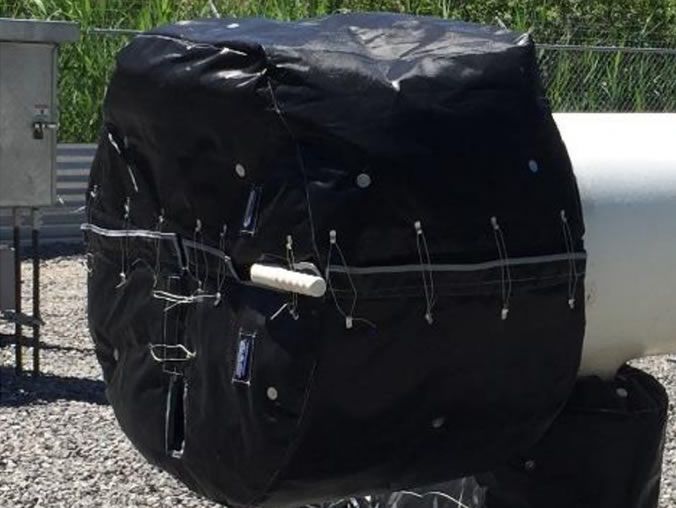SHANNON SAFETY SPRAY SHIELD
SSS-450-FJT (SSS-232C-FJT)
INTRODUCTION
Shannon Safety Shields are a CAD designed, CNC produced, high quality custom fit protective composite jacketing. Safety Shields are designed to address potential flange rupture leaks, deflect potential effluent and contain liquid discharge, protecting the surrounding work environment. Shannon Safety Shields are weather and chemical resistant. Shannon Safety Shields are flexible and easy to install, remove and reinstall allowing quick access and easy equipment serviceability. The key benefit is re-usability.
Engineering Standards
Shannon Safety Shields follow the ASTM D3786 Mullen Burst Test per ASTM F1138 (Spray Shields for Mechanical Joints)
Applications and Markets:
Applications include: Flanged Valves, Flanges, Equipment & Equipment Heads, Instrumentation and Complex Surfaces that otherwise are left untreated. Markets include; Chemical and Petro Chemical Processing Plants.
Service Temperature:
This design is to act as a Thermal Barrier with a maximum service temperature of 232˚C (450˚F).
Product Components
The Inner Jacketing will be as follows: 1 (each) Layer – 19.0oz/yd² (645g/m²) PTFE Non-Porous Teflon® Film Laminated and Impregnated Fiberglass Cloth Insulation Core Material is an 11lb/ft³ (176.2 kg/m³ ) High Density Fiberglass Needled Mat – Type E Interwoven Fiber. The Outer Jacketing will be as follows: 16.5oz/yd² (560g/m²) PTFE Teflon® Impregnated Fiberglass Cloth.

Pig Launcher – Head
SHANNON SPRAY SHIELD THICKNESS TO SURFACE CONDITION
(OPTIONAL) TEMPERATURE REFERENCE:
Operating Temp |
Thickness |
Surface Temp |
Thickness |
Surface Temp |
Thickness |
Surface Temp |
|---|---|---|---|---|---|---|
| 121˚ C (250˚ F) | 25 mm( 1″) | 37.9˚ C (100.2˚ F) | 40 mm( 1.5″) | 33.3˚ C (92.0˚ F) | 50 mm (2″) | 30.8˚ C (87.4˚ F) |
| 149˚ C (300˚ F) | 25 mm( 1″) | 42.6˚ C (108.6˚ F) | 40 mm( 1.5″) | 36.8˚ C (98.2˚ F) | 50 mm (2″) | 33.5˚ C (92.3˚ F) |
| 177˚ C (350˚ F) | 25 mm( 1″) | 47.3 ˚C (117.2˚ F ) | 40 mm( 1.5″) | 40.3˚ C (104.6˚ F ) | 50 mm (2″) | 36.3˚ C (97.4˚ F ) |
| 204˚ C (400˚ F) | 25 mm( 1″) | 52.2˚ C (126.0˚ F) | 40 mm( 1.5″) | 44.0 ˚C (111.2˚ F) | 50 mm (2″) | 39.3 ˚C (102.7˚ F) |
| 232˚ C (450˚ F) | 25 mm( 1″) | 57.2˚ C (135.1˚ F) | 40 mm( 1.5″) | 47.8 ˚C (118.0˚ F) | 50 mm (2″) | 42.3 ˚C (108.2˚ F) |
* The above referenced Cold Face Surface Temperatures should be used as guidelines for blanket insulation thickness design.
* The Cold Face Surface Temperature of the blanket should approach surrounding ambient temperature conditions.
* The economic thickness of the blanket should consider blanket cost, thermal performance and blanket design constraints.
* Heat loss calculations are based on a 21.1˚ C (70˚ F) ambient temperature using a flat surface condition.
